Principals and Practices
The Fab Charter
The Fab charter is a quick run down of the rules and purpose of a Fab Labs and Fab Newtork. It states that a Fab Lab is a local space available to all members of a community to provide individuals with tools, training, and other resources related to digital fabrication. The fab netwrok as a whole offers indiciduals acces to far more than what a single lab can offer, and instead offers acces to information from labs accross the world. It is the responsibility of each member of a Fab Lab to be safe, and respectful as well as document and add further knowledge for other users. Inventions created in a fab lab belong to the individual who made it and make commercialize and sell it under the restriction that the invention remains available for other users to learn from. Buisness's are free to use Fab Labs under the condition that they do not break any of the rules, and do not conflict with other users. They are expected to benefit the inventors and labs that helped make their invention grow.
The Fab charter is a quick run down of the rules and purpose of a Fab Labs and Fab Newtork. It states that a Fab Lab is a local space available to all members of a community to provide individuals with tools, training, and other resources related to digital fabrication. The fab netwrok as a whole offers indiciduals acces to far more than what a single lab can offer, and instead offers acces to information from labs accross the world. It is the responsibility of each member of a Fab Lab to be safe, and respectful as well as document and add further knowledge for other users. Inventions created in a fab lab belong to the individual who made it and make commercialize and sell it under the restriction that the invention remains available for other users to learn from. Buisness's are free to use Fab Labs under the condition that they do not break any of the rules, and do not conflict with other users. They are expected to benefit the inventors and labs that helped make their invention grow.
 Fab Charter
Fab Charter
 3D Experience Fab Lab supported by Dassault Systeme
3D Experience Fab Lab supported by Dassault Systeme
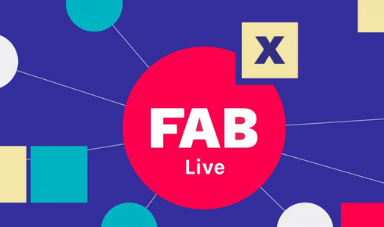 Fab Network Live Conference
Fab Network Live Conference
The IPi
For this final project I intend to be working with a peer of mine John Proctor. The IPi short for Imagine Pi is a modular hub for fab lab management. The Imagine Spaces is the name given to the network of labs at my college including a makerspace, machineshop, fiber lab, and VR lab. However a big problem that comes is how to manage who has access to what, who has been trained on what, and who is currently where. The current system we use solves only a single of those problems where we are given a wooden laser engraved card which can get stamps to show proficency in a machine. The IPi aims to solve all of these problems in a far more elegant manner. The IPi works by connecting to other modules with the primary module being an nfc reader/writer with a few buttons and a lcd screen. This device will be used by staff to update individuals nfc cards that they have shown proficency or have been trained on a machine. This will work with the device having buttons that can be pressed while a card is inserted in order to add a mark for the corresponding machine. In addition to this a reader will be used at the front door for users to scan their cards where on a monitor the time they arrived, their level of access, and their photo will be displayed on a monitor. By placing these devices throughout all the labs accross campus, and connecting them all together via a common server or service such as aws or github respectively, information from all labs can be displayed on the monitor. The IPi will serve to bring together the imagine network at my college and finally put an end to the obsolete pieces of wood we use to track key information.
Due to me having no drawing skills whatsoever, and not having enough time to make a proper CAD design I made a schematic to show parts of the connections needed in KiCad showing the connection between the Pi and an attiny 1616 component linked to a few buttons (ignore the lack of resistors on the I2C bus).
For this final project I intend to be working with a peer of mine John Proctor. The IPi short for Imagine Pi is a modular hub for fab lab management. The Imagine Spaces is the name given to the network of labs at my college including a makerspace, machineshop, fiber lab, and VR lab. However a big problem that comes is how to manage who has access to what, who has been trained on what, and who is currently where. The current system we use solves only a single of those problems where we are given a wooden laser engraved card which can get stamps to show proficency in a machine. The IPi aims to solve all of these problems in a far more elegant manner. The IPi works by connecting to other modules with the primary module being an nfc reader/writer with a few buttons and a lcd screen. This device will be used by staff to update individuals nfc cards that they have shown proficency or have been trained on a machine. This will work with the device having buttons that can be pressed while a card is inserted in order to add a mark for the corresponding machine. In addition to this a reader will be used at the front door for users to scan their cards where on a monitor the time they arrived, their level of access, and their photo will be displayed on a monitor. By placing these devices throughout all the labs accross campus, and connecting them all together via a common server or service such as aws or github respectively, information from all labs can be displayed on the monitor. The IPi will serve to bring together the imagine network at my college and finally put an end to the obsolete pieces of wood we use to track key information.
Due to me having no drawing skills whatsoever, and not having enough time to make a proper CAD design I made a schematic to show parts of the connections needed in KiCad showing the connection between the Pi and an attiny 1616 component linked to a few buttons (ignore the lack of resistors on the I2C bus).
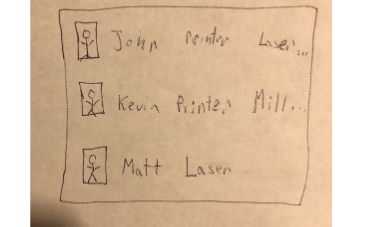 Potential Design for Monitor Display Showing Where Users are and what they are Trained on
Potential Design for Monitor Display Showing Where Users are and what they are Trained on
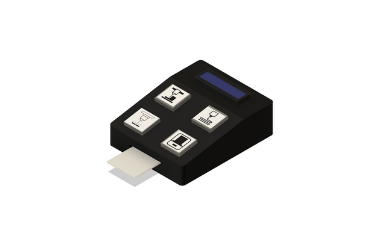 Potential Design for NFC writer
Potential Design for NFC writer
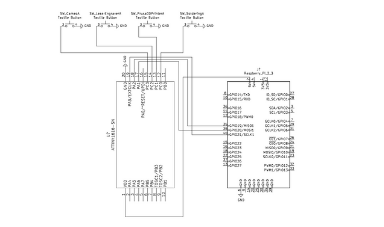 Initial Rough Schematic I made on KiCad showing Connection between Pi and Attiny 1616 for Proof of Concept
Initial Rough Schematic I made on KiCad showing Connection between Pi and Attiny 1616 for Proof of Concept
How it Will Work
A large part of this project will rely on using an I2C bus. The purpose of the IPi is to be a modular device where many other components can be linked to it, which will also link to all the other IPi's and corresponding components in the Imagine Network. However to link many complex devices a single pi there are not enough GPIO pins, especially if we are using Pi minis which are cheaper and more compact. Instead there is a far better approch using and I2C bus. An I2C bus works by using a master device (in this case the pi) which connected to multiple slave devices (microcontrollers in this case attiny 1616) in a single connection. The Master device sends through the connection an address, followed by 7 bits of data, and an acknowledgement check to make sure that each slave device is receiving the information. The rate of this information is dictated by the SCK or serial clock which is controlled by the master device. This in turn will allow me to connect multiple attiny's each with their own components to one another and the the pi as well as the imagine network. For example this allows me to conect an lcd screen, multiple buttons, and an nfc reader/write all by using 3 attiny and a single I2C bus.
A large part of this project will rely on using an I2C bus. The purpose of the IPi is to be a modular device where many other components can be linked to it, which will also link to all the other IPi's and corresponding components in the Imagine Network. However to link many complex devices a single pi there are not enough GPIO pins, especially if we are using Pi minis which are cheaper and more compact. Instead there is a far better approch using and I2C bus. An I2C bus works by using a master device (in this case the pi) which connected to multiple slave devices (microcontrollers in this case attiny 1616) in a single connection. The Master device sends through the connection an address, followed by 7 bits of data, and an acknowledgement check to make sure that each slave device is receiving the information. The rate of this information is dictated by the SCK or serial clock which is controlled by the master device. This in turn will allow me to connect multiple attiny's each with their own components to one another and the the pi as well as the imagine network. For example this allows me to conect an lcd screen, multiple buttons, and an nfc reader/write all by using 3 attiny and a single I2C bus.
 I2C SDA line
I2C SDA line
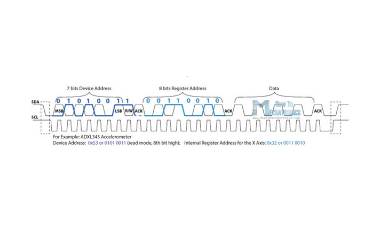 I2C Relation between SDA and SCL
I2C Relation between SDA and SCL
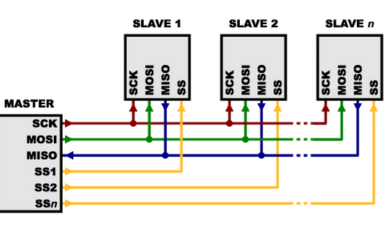 Single Master Multiple Slave I2C bus Example
Single Master Multiple Slave I2C bus Example